A peep into western Russia in 2011 - Part 1
(Travel Story Series @ Hon Too Fang 2021)
In the second week of June 2011 my wife and I, together with 2 others, went to tour Russia and the adjoining Baltic states of Latvia, Lithuania and Estonia, all former republics of the communist Soviet Union. We were there for a month. This is our "adventure" story, on Russia alone. Certainly one of the more adventurous trips we have made.
Prelude
In February 2011 a 30+ Hong Kong academic, GW, posted on a backpacker website about his planned travel to Russia and the Baltics. He was soliciting for a travel companion. An old Malaysian solicitor in his 70s, NL, responded to the solicitation in March. In May, I learned about the plan from NL and in no time booked flights for me and my wife to join the backpacking trip. So this is a motley crowd of 4 assembled for the trip. During the tour of the cities the young GW was usually on his own. The 3 senior Malaysians clang on together for dear life most of the time. Sometimes NL would go separately for an afternoon too. That is the beauty of a self-planned tour.
Flight: time is money
NL booked his flight "KL-Beijing-Moscow" in March, paying around RM 3,400 returns. We booked the same flight in May and we had to pay RM 800 extra each. Time really means money. And we shouldn't waste time. So you are nodding your head in unison. But why are you still wasting time following this email?
Russia and rasuah
In the Malay language Russia is aptly pronounced as "rasuah". We have to pay duit kopi even before we are allowed to enter Russia. You see, to get a Russian visa you need an invitation from a Russian national. What kind of rule is this? So where to get the invitation letter? Googling the internet yielded several companies offering such service. One can purchase online but need to pay about US$ 30 total for such a letter couriered to our home. So I made inquiry to the office of the Russian Consulate in Malaysia on the validity of the invitation letter.
"Oh, those from the internet eh? I am not sure. Depending on what organisation is issuing them. May be we need time to check them thoroughly. Oh, you going in 3 weeks' time eh? Very tight loh! We are not responsible for any delay you know, if your documents are not in order. May be you can contact this local agent. Easier!"
No hint of rejection is uttered. The implied threat of you not getting your visa in time if you don't engage the friend's service is enough for you to abandon any thought of doing it otherwise. So we paid RM 800 each for our double-entry visa, RM 350 official fees collected by the Consulate and RM 450 duit kopi. Pure corruption. Sell the letter for money.
Isn't it something similar to the AP system for importing cars started by our BN government?
Up to now I still don't know who issued the invitation letter to us to visit Russia. May be PM Putin. Ours is a double-entry visa because we entered Russia twice on the trip. No visa is required for the other 3 Baltic states.
Moscow and Morse Code
A great difficulty faced by us in Russia is language. Very few people on the streets speak English. Even their metro (subway) stations and all street names in Moscow, the capital, and other small towns display only the names in Russian. Only St Petersburg has some English street names.
The English language uses the Latin alphabets. The Russian language uses Greek alphabets, α (alpha), β (beta), φ (phi), ε (epsilon) etc, etc. Absolutely alien to us, like an algebra puzzle. We have to take snap shots of names of our hostels, metro stations, etc, and keep them in our camera for asking directions. So Moscow should be pronounced as "Morse Code".
Because of the lack of street signs in English, Moscow was voted in the US as one of the top 3 cities in the World to "lose" your wife. Ya, now you know why I had invested RM 4,200 to buy the air tickets for my wife. But alas, my investment was not fruitful. She was too vigilant to get lost.
Russia the country
Russia is a huge huge huge huge country. In fact it is the biggest country in the World. Area wise it is 52 times that of Malaysia, and about 1.8 times that of USA or China. Population about 143 million.
In Russia we visited their 2 main cities of Moscow and St Petersburg (former name: Leningrad) and 3 small towns of Pskov, Pechersky and Novgorod.
All of them are located in the far western corner of the country, the location of Moscow and St Petersburg as shown in the map below. The other 3 small towns are located west of St Petersburg, near to the bother with Estonia. That is why the title chosen for this story is “A peep into western Russia”. Only a peep into a small corner of Russia.
The topography
The countryside where we passed through in that western corner, by train or bus, are mostly very flat forested land, sleepily monotonous. But the Russian women are not flat. Twin peaks and deep valleys. Eye-poppingly refreshing. Slim and tall, eye lashes long and curly, everyone a Maria Sharapova. The younger ones of course.
The city metros
Both Moscow and St Petersburg are served by an extensive network of subways, trains running at intervals of only a few minutes. The subways in St Petersburg are reputed to be the deepest in the World, up to 4 levels. And the metro stations are the most beautiful in the World. The following look more like the lobbies of 5-star hotels, than a public facility. First 2 from Moscow and the other 2 from St Petersburg.
(Note in 2021: photo quality is not good as the digital camera in 2011 has less pixels and lower ISO number, unable to take sharp pictures in such dimly lighted places)
Warm Russia and cold Russians
During our visit Russia was unseasonably warm, with high near to 30 degrees C. But the Russian people were cold. Due to the alphabet problem we had to stop people on the street to ask for directions. We tried to wave our hands in front of a young man coming in our direction. One out of 3 would step away and continue walking, without even making any eye contact with us. Another one might look at us, made a sign of "I don't know" and continued walking. The 3rd one might stop, and more likely shook his head after hearing we were speaking in English. The older people might be more entertaining, and engaged us in conversation, in Russian of course. Chicken talking to a duck. No result though.
Food in Russia
We certainly had difficulty if we wanted to order ala carte in a restaurant in Russia, even those in the tourist districts. The most welcome restaurant sign we looked for was "kaΦe" which is cafe. In such cafe, pre-cooked food are displayed, you just choose what you want. Like the mixed-rice 杂饭 stalls in our coffee shops. Very fair in pricing too, they even weigh your salads to determine the cost of each choice.
In general kebabs are quite easily available. In the cities burgers are easily available too. And a common dish is actually steamed dumplings stuffed with meat: pork or chicken, called “pelmeni”. Shape and taste just quite like the "siau long bao 小龙包" offered in Shanghai or the Dragon-i Restaurants in KL, but bigger in size. This is a common dish in Russia and some of the former republics of the Soviet Union, said to have originated from Siberia or the Mongols brought them to Siberia from China. And all the while I thought this "siau long bao" is a Shanghai special.
While in Pechersky visiting a famous monastery we had lunch at a restaurant there and as usual had difficulty to order. The menu was of course in the alien Russian. Then the lady boss ushered us to the bar counter to look at her laptop. Wow, got some menu in English stored in her laptop. So I ordered an exotic roast pork trotter and coleslaw. And you know what came: plain boiled chicken drumstick, and the salad was cucumber plus tomato. I really didn't know what happened. I shrugged my shoulder and cursed in Hokkien, she shrugged hers and cursed in old Slavic!
My wife loves milk. I don't, but I do appreciate beautiful natural milk containers. We used to buy a packet of milk at shops at the end of the day so that she could drink it the next morning. But we could not differentiate milk and plain yogurt from the labels. Any brand with the image of a cow became our first choice. And twice the "milk" turned “sour” the next morning. She dared not drink and had to throw it away. We could have bought yogurt instead. Of course yogurt is soured milk! One turned sour naturally and you throw it away. One turned soured artificially and you drink it! What kind of upside-down World is this?
Wedding limousine
Saw quite a number of newly-weds having their photo shoots in parks and other famous landmarks on this trip. One thing is common: long long limousines were used. I had a peep of the inside of one such car: can sit up to 10 or 12 passengers, facing each other along the length of the car. All the bride's "chi mui 姐妹" can go inside. Cool.
Cost of living in Russia
Real estate is very expensive in Moscow so accommodation is expensive. Food prices in Russia are less than those in western Europe. Public transport is subsidised and operated by the government. Subway train fare is on a "per entry" basis, about RM 2.50 to RM 3.00. Similar fare structure for buses too. But entry to public toilets was expensive. In St Petersburg we had to pay nearly RM 3 for each visit. My mother would complain a 30 sen charge at the Pudu Bus Station as blood-sucking, black-hearted. She would have fainted if she was told to pay RM 3!
What to see in Russia: churches
Mostly churches, palaces, forts, monuments and museums in the cities we visited. Many churches were destroyed during the communist era, then rebuilt and restored to the former glory, but some were converted into museums. These are Russian Orthodox churches, topped with the iconic domes: I call them the onion heads.
What to see in Russia: palaces
These are the residences of the tzars, Peter the Great, Catherine the Great, etc, etc. Everyone is a Great. Rather similar to those in other parts of western Europe. What else could you showcase your wealth and your power but big big palaces and gilded furniture and decorations! Well, 300 years ago, you don't have Ferrari to drive, Herme's Birkin handbag to carry or gold-plated iPhone 6 to connect mah! The photo below shows tourists at the famed garden of Peterhof in St Petersburg. Everybody taking shots, must be something very photogenic or photo-worthy.
Moscow (1) – the Red Square
Now we go touring. Our first stop is Moscow, founded in the 12th century and now the capital. It is one of the biggest cities in the World with about 12 million people in the city and 20 million within the metropolitan limits.
The Red Square is a UNESCO World Heritage site and the number one attraction for tourists, comprising many buildings. The 1st 2 photos show the Voskresensky Gate leading into the complex, with a small chapel. The gate was 1st constructed in 1680 and the current one dates to 1996, said to be an exact replica.
The next photo shows part of the Red Square, with the Kremlin on the left, and the St Basil Cathedral on the right. The location of the Cathedral marked the geometric centre of the old city. The Red Square is also the venue of Russia’s military parades. Here construction machinery is seen at work preparing for the annual Moscow Victory Day Parade due in a week’s time.
Two notable buildings at the square are the State Historical Museum completed in 1883 and the GUM Departmental Store built it 1893, the best known shopping centre in Moscow. We paid for a visit to the State History Museum, shown 4 exhibits. A famous exhibit is the Mstislav Gospel with 213 leaves of parchment dated to the 12th century. Another is a bronze sculpture by F Shubin in 1770 titled “Time, Fortune and Poverty”.
There are 2 famous church buildings here. The Kazan Cathedral was founded in the 1620s. It was demolished by the communist government in the 1930s, one of the first churches to be demolished by the regime. The present one, a replica, dates to 1993.
The iconic building here is of course the St Basil Cathedral originally built in 1555-1561 under the order of Tsar Ivan the Horrible. It is one of the oldest buildings on the square. The unusual use of multi colours is attributed to the depiction of the Heavenly City in the Book of Revelation, a book in the Bible. What is particularly striking about the cathedral is its asymmetrical architecture, and its striking colour heterogeneity. It is now a museum, with only occasional religious service. Right in front of the cathedral is the Monument to Minin and Pozharsky, 2 national heroes.
Moscow (2) – the Kremlin
The Kremlin is the old palace of the tzars and now the official residence of the President of the Russian Federation. The 1st recital appeared here in the 11th century, and the word “kremlin” meaning “fortress inside a city” was coined in 1332. It is a huge complex with 5 palaces, 4 cathedrals and the enclosing Kremlin Walls and Kremlin towers. Shown 2 shots of the Kremlin Wall (2.2 km long) and watch towers. There are 20 towers.
There are 3 cathedrals and 2 churches at the Cathedral Square, all declared as heritage buildings. Several have been turned into museums. The 6.14 m height Tsar Bell dates to 1735.
And shots at the Alexander’s Gardens, with the Tomb of the Unknown Soldier.
Moscow (3) – Cathedral of Christ the Saviour
This is the largest church building in Russia originally built in 1883. It was demolished by the Lenin-led communist government of the Soviet Union in 1931. Just imagine, a big functioning new building just wastefully demolished because the communist regime consider religion a social ill. After the fall of communism, it was rebuilt with public fund, completed in 2000. The dome is 105 m high, and the church can accommodate 10,000 people. The interior is beautifully decorated but photography strictly prohibited. The last 2 photo show scenes of the Moskya River running at the back of the church. Buildings in the background in the last photo are part of the Kremlin.
Moscow (4) – Novodevichy Convent
First a few words about the Russian churches. Most Russian Christians belong to the Russian Orthodox Church which is part of the Eastern Orthodox Church. And the Eastern Orthodox Church is the 2nd biggest church group in the World, after the Catholics. Their communities are mainly found in South-east and Eastern Europe and the Caucasus region. They split from the Catholics in the mid-5th century over some lesser points of faith but remained friendly or, in religious terms, in communion with each other. But all this changed in 1054 in the East-West Schism when the communion ceased. The Eastern Orthodox Church refused to accept the Pope of the Catholics as the administrative head of Christianity.
Though they are considered as a group, the Eastern Orthodox Church does not have a common head, like what the Catholics have in the position of the Pope. Each country or region has its own system with an arch bishop or Patriarch. The Patriarch of Constantinople (Istanbul) is recognised and respected as the “First among Equals”. The Patriarch of the Russian Orthodox Church is ranked only 6th despite having the biggest number of the Christian followers. Ranking is based on history. The 1st five positions all have a longer history.
Externally the Russian Orthodox churches always have the iconic colourful domes with long spires. They decorate the buildings with a lot of images, or icons, of Jesus, the Virgin Mary and a host of saints. Photography is usually prohibited inside the church, unless they have been converted into museums. That explains why I don’t show photos of internal decoration of the churches in this story.
This Novodevichy Convent is the most famous cloister in Moscow, dating back to 1524. It is closely linked to Russian politics. Many women from the tsar’s family and the aristocracy stayed here for various spells. It received a royal grant every year. Kind of a royal convent. It has been functioning continuously since 1524. It is a UNESCO World Heritage Site for its accomplished Baroque architecture and richly decorated interior.
The convent is a sprawling complex. Most of the buildings were completed in the 1500s.
The iconic building here is the 5-domed Cathedral of Our Lady of Smolensk, the original church. Others: the 72 m tall octagonal shaped bell tower built in 1690, Church of the Assumption, the cute Church of St Ambrose of Milan and part of the dorms.
At the time of our visit the convent was having an art exhibition of paintings of its own buildings, presented in various styles. Two shown.
Moscow (5) – The Novodevichy Cemetery
This cemetery, next to the convent we just covered, is ranked the 3rd most popular tourist site in Moscow, a rather unusual choice. It was inaugurated in 1898 and over 27,000 people have been buried here. Now only the VIP could have a place. It has a park-like ambiance and many of the tombs have simple but attractive sculptured tombstones.
The cemetery wall is used as a columbarium, 1st photo. Next is the tomb of Paisa Gorbacheva, wife of Mikhail Gorbachev, the last President of the Soviet Union. Then the tomb of a footballer Vladimir Fedotov. Two war heroes. Next one with an artistic tombstone. Lastly that of Boris Yeltsin, the first President of modern Russia. A marble piece shaped like a waving Russian flag, no name inscribed and the area is not bigger than other tombs.
Moscow (6) – Some communist-era monuments
All communist governments have the practice of constructing impressive monuments to boost their achievement, real or otherwise. This 1st series shows the Monument to the Conquerors of Space showcasing the advancement of the Soviet Union into space. It was completed in 1964. The 107 m tall giant obelisk depicts a starting rocket that rises on its exhaust plume.
The 2nd series are from the All-Russia Exhibition Centre, completed in 1939 to show nation building. It is also a permanent general purpose trade show and amusement park. A huge place with more than 80 pavilions and 200+ other buildings.
The 1st photo shows the Triumphant Arch main entrance. The 2nd photo is the famous monument of "Worker and Kolkhoz Woman". The 24.5 m high stainless steel sculpture was made in 1937 for the World Fair in Paris, and subsequently moved to Moscow. The statue in the 3rd photo is that of Lenin, with the Main Pavilion in the background.
Then pavilions belonging to the former republics within the Soviet Union: Uzbekistan, Ukraine and Armenia. And lastly the Fountain of Friendship of All Nations.
And as a public park, we have children doing high trampoline jumping and kite flying.
Moscow (7) – At the parks
Took a 2-hour walk in a park called the Tsaritsyno Park founded in the 16th century by Catherine the Great, with a huge lake and a musical fountain. The Ornate Bridge here looks like a fortress.
We also hiked up the Sparrow Hills in another park, near to Novodevichy Convent. The hills have been immortalised by many Russian poets and writers. The main landmark is the iconic Moscow State University which was once the tallest building in Europe. Peonies are in full bloom here, with huge flowers. Bigger than those in Luoyang, China.
Moscow (8) – Miscellaneous
We also enjoyed an evening of entertainment at the famed Moscow Circus. Our mid-row seats cost about RM 80 each.
Saying good bye to Moscow – at the railway station where we are taking the night express to Riga, Latvia, one of the Baltic states we are visiting. The most popular souvenir from Moscow is a set of the nesting (Matryoshka) dolls, which are painted wooden dolls of decreasing sizes one hidden inside another. The common ones for tourists are a set of 4.


























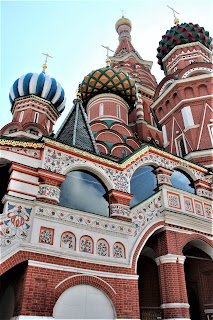
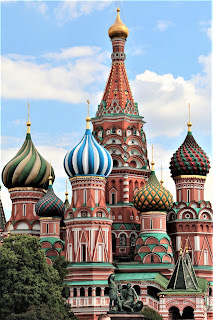













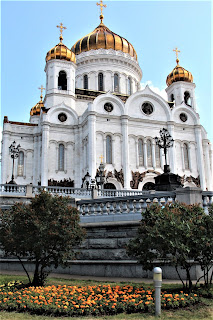





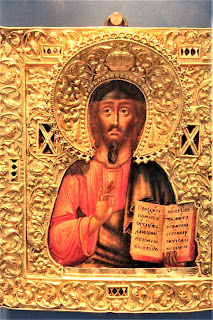









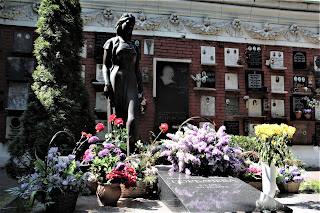














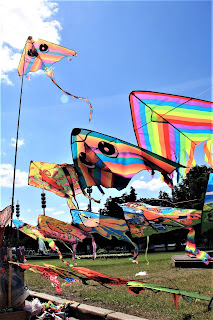





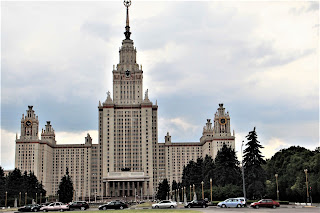






No comments:
Post a Comment